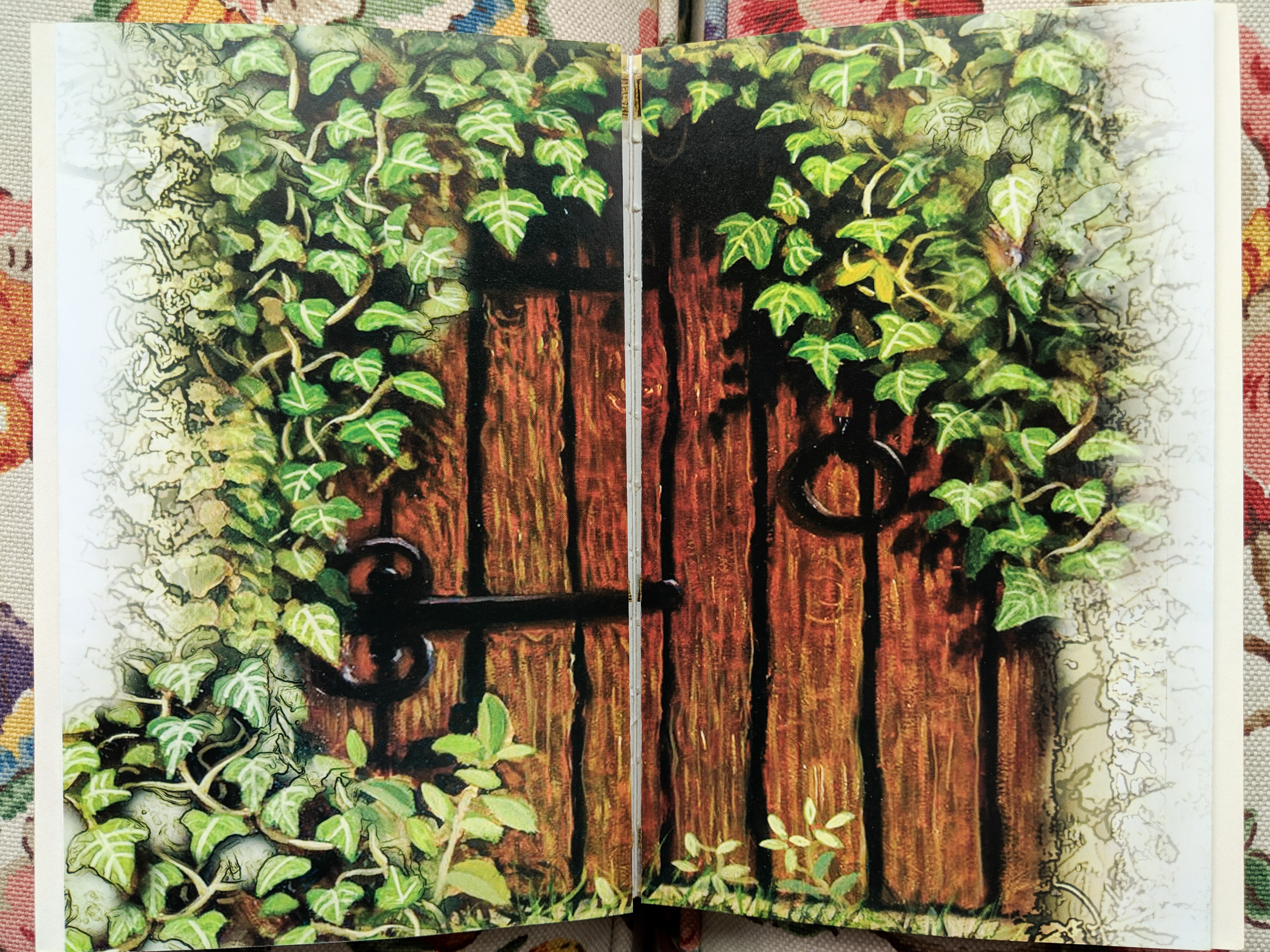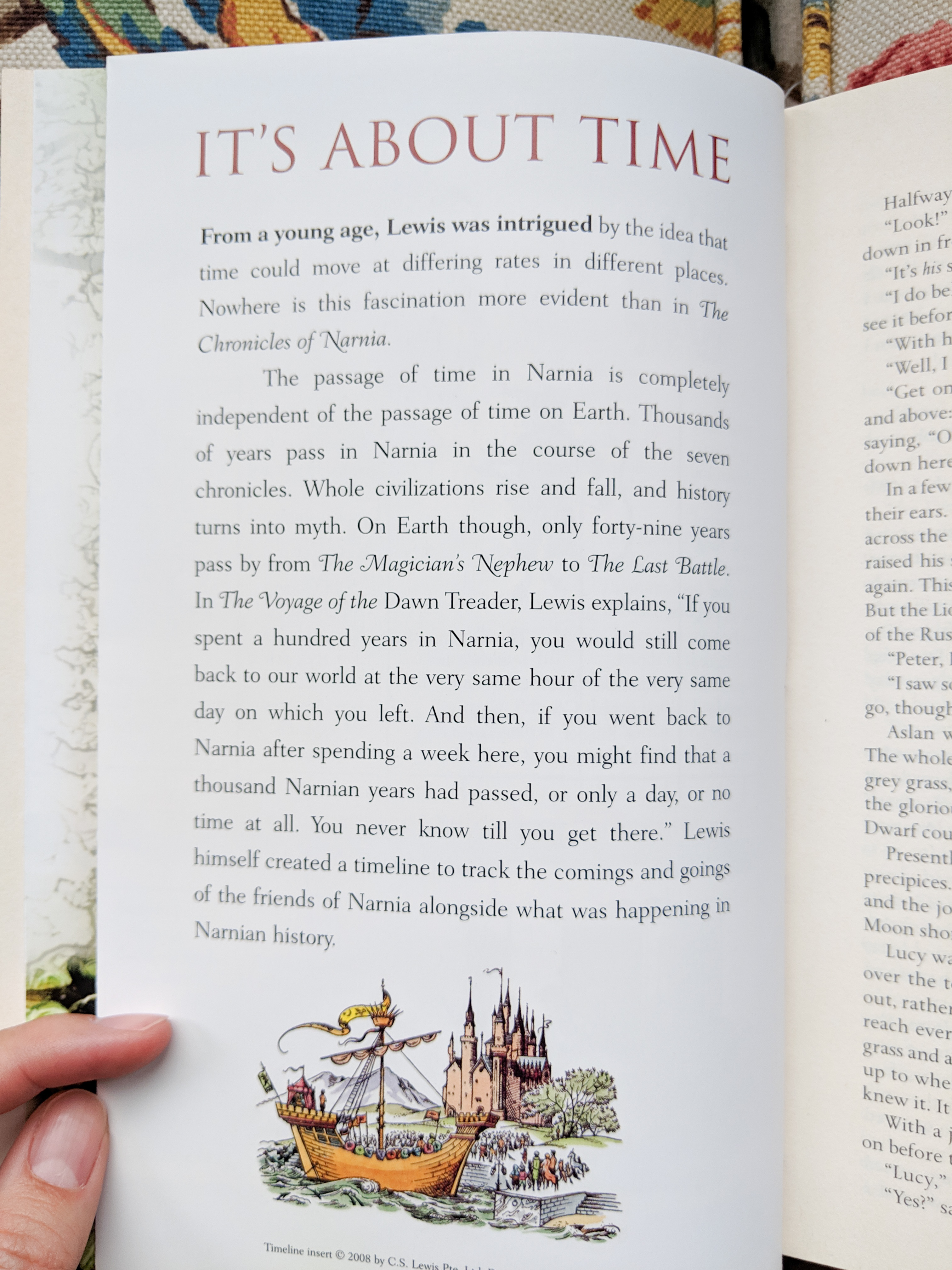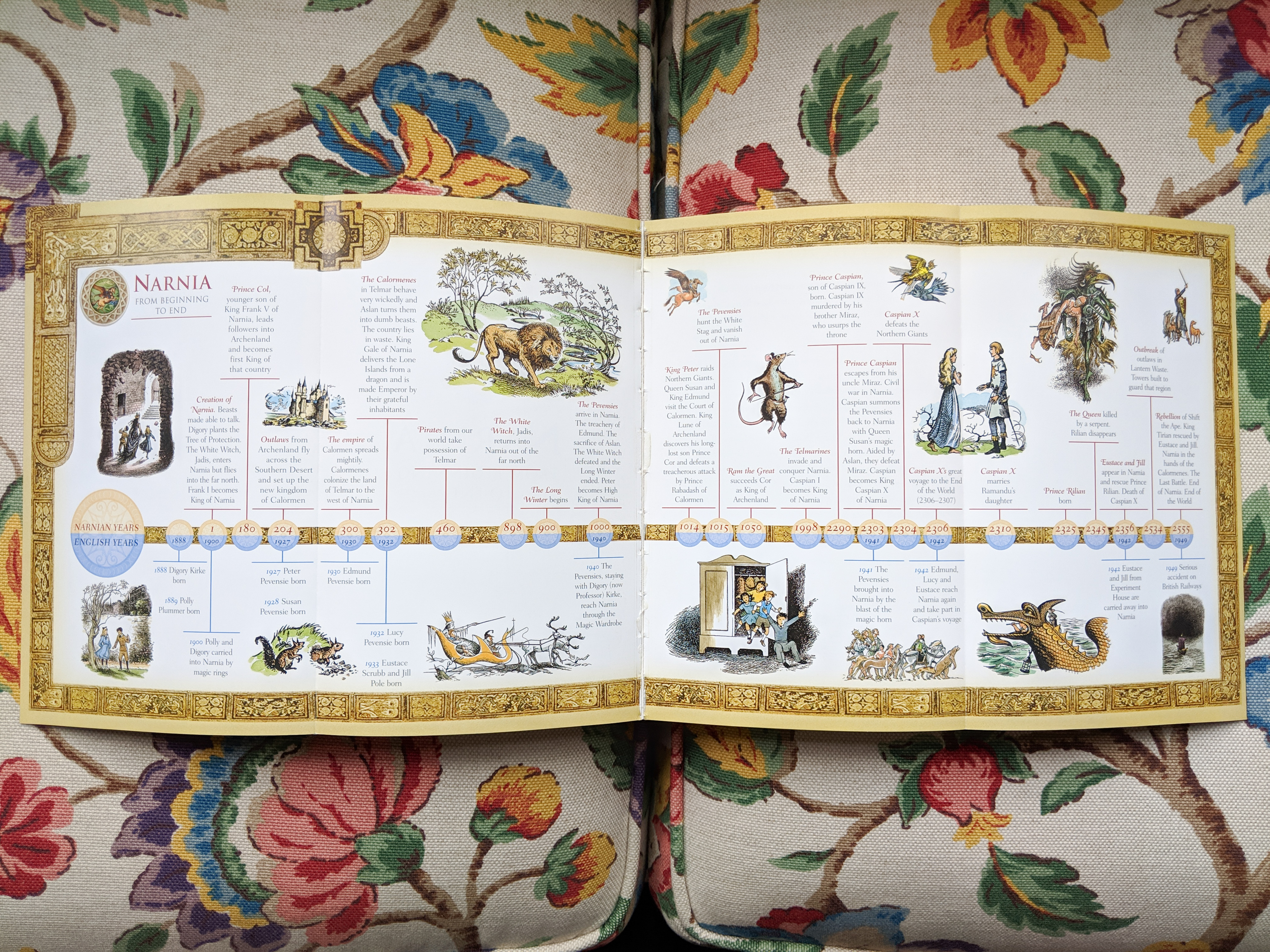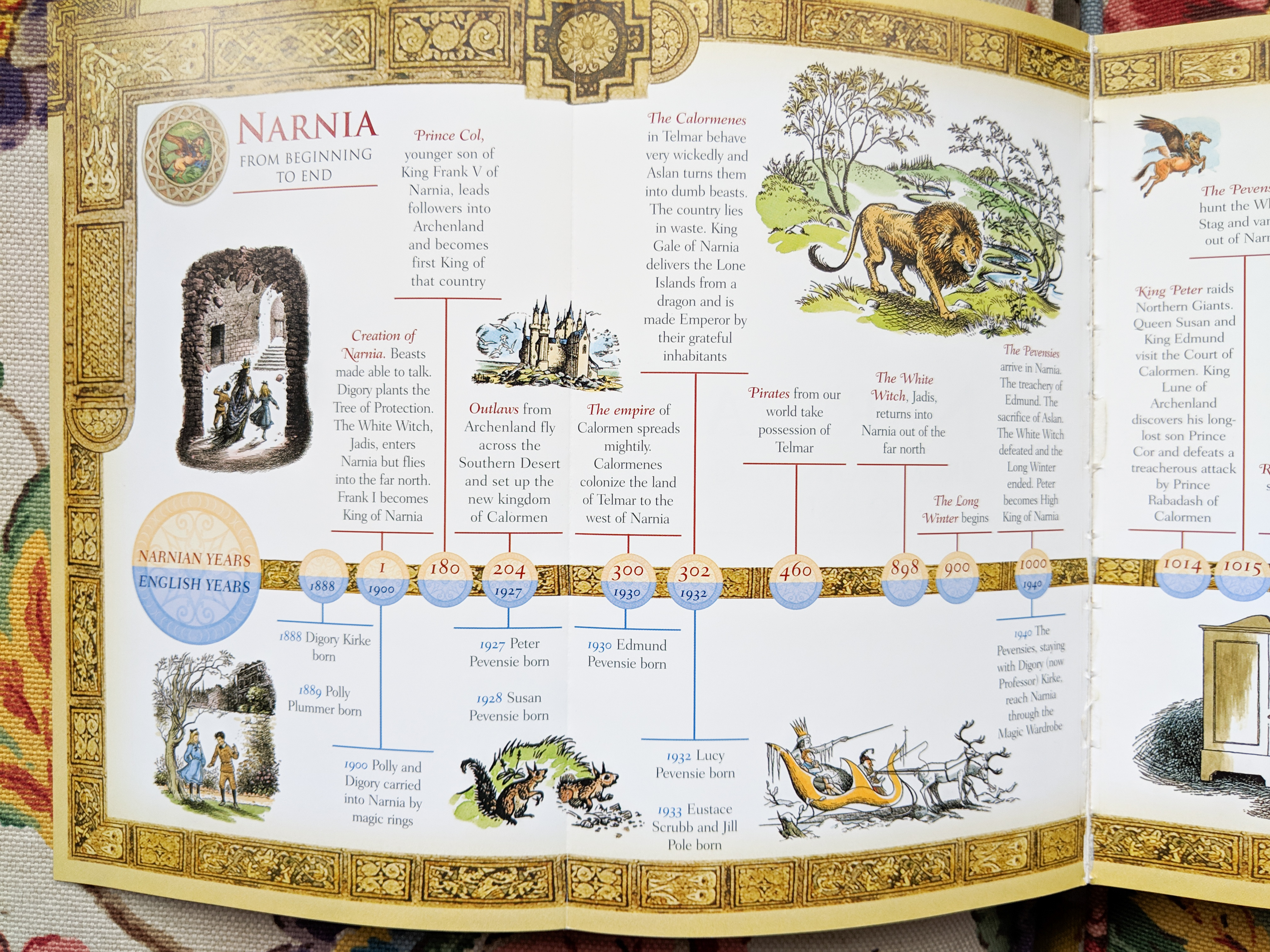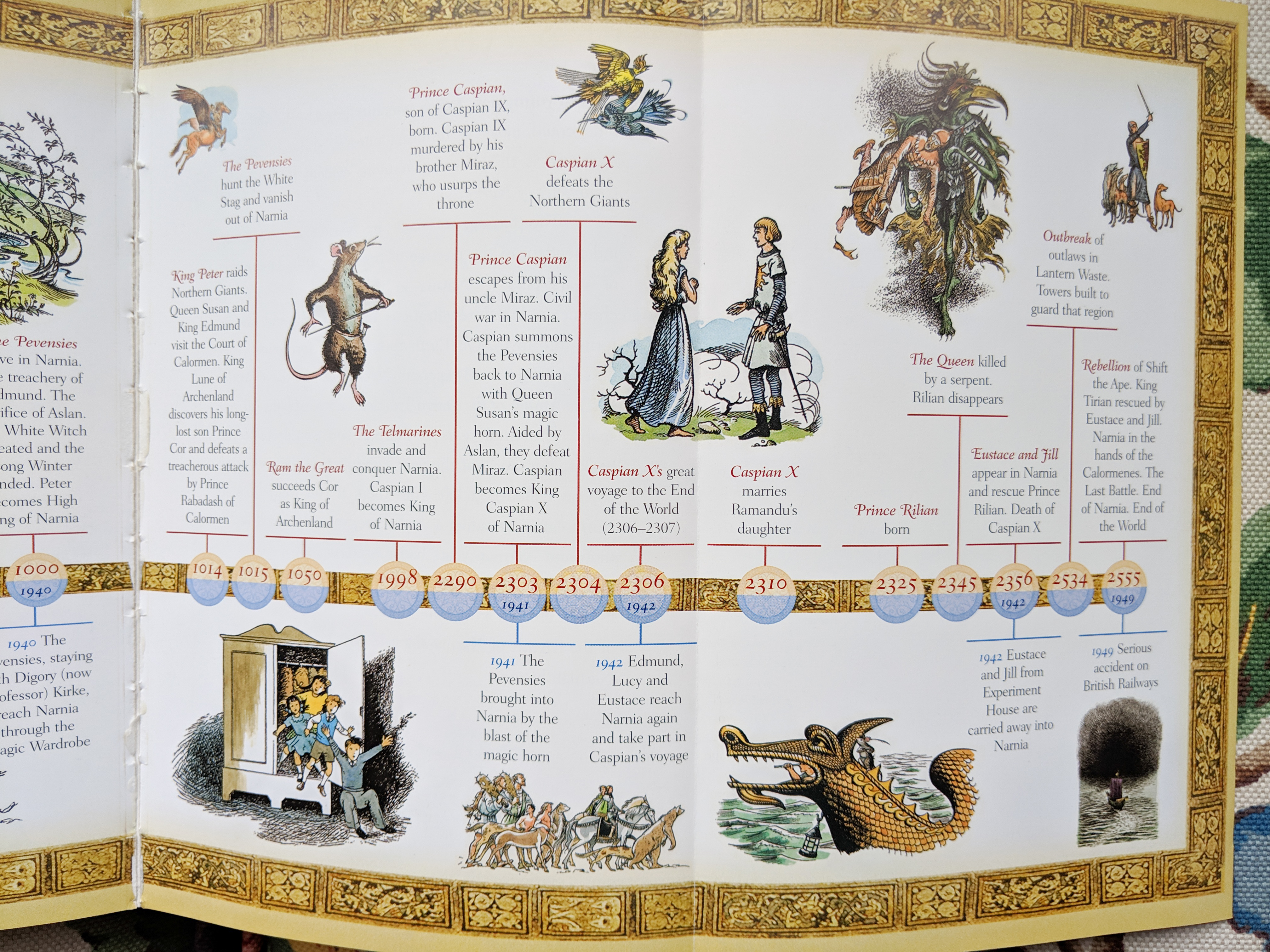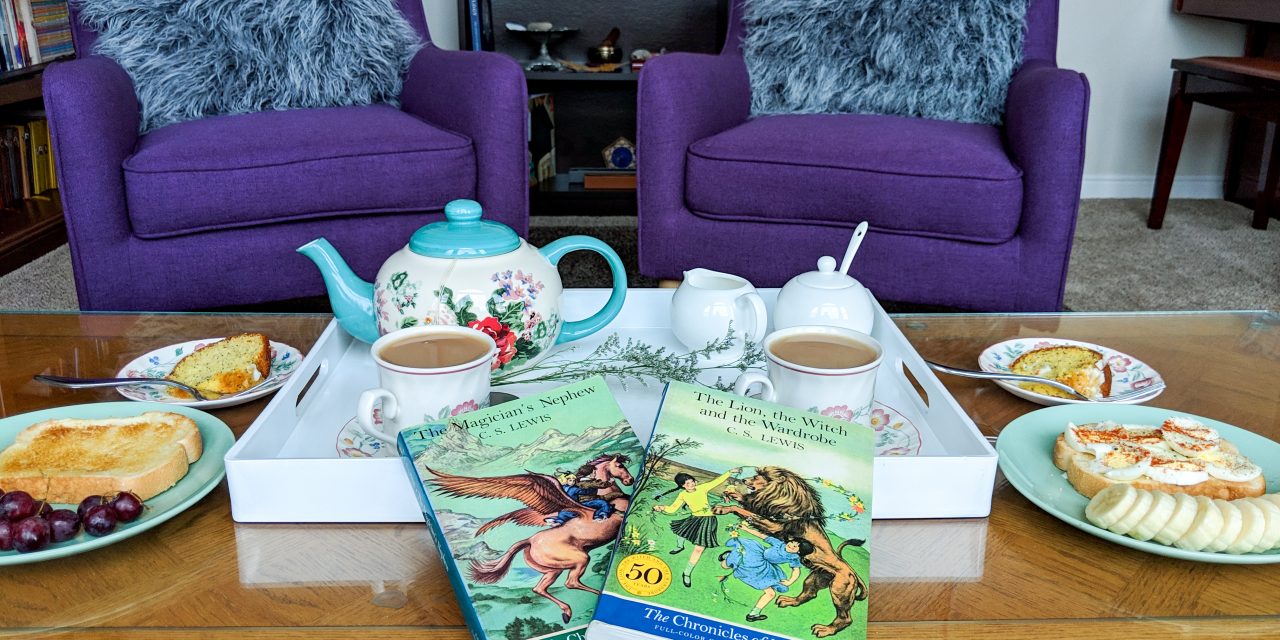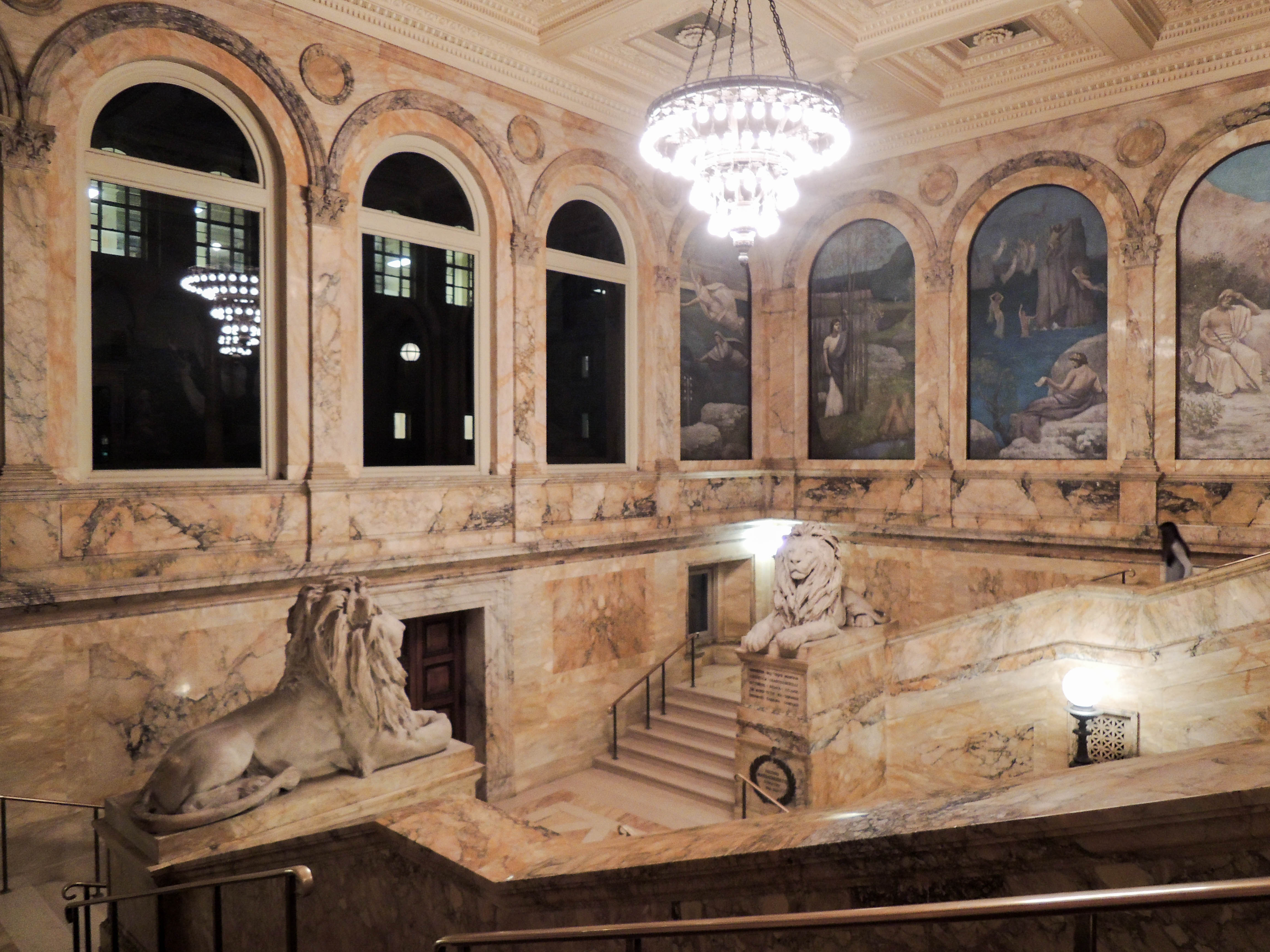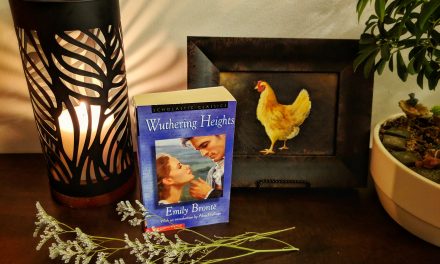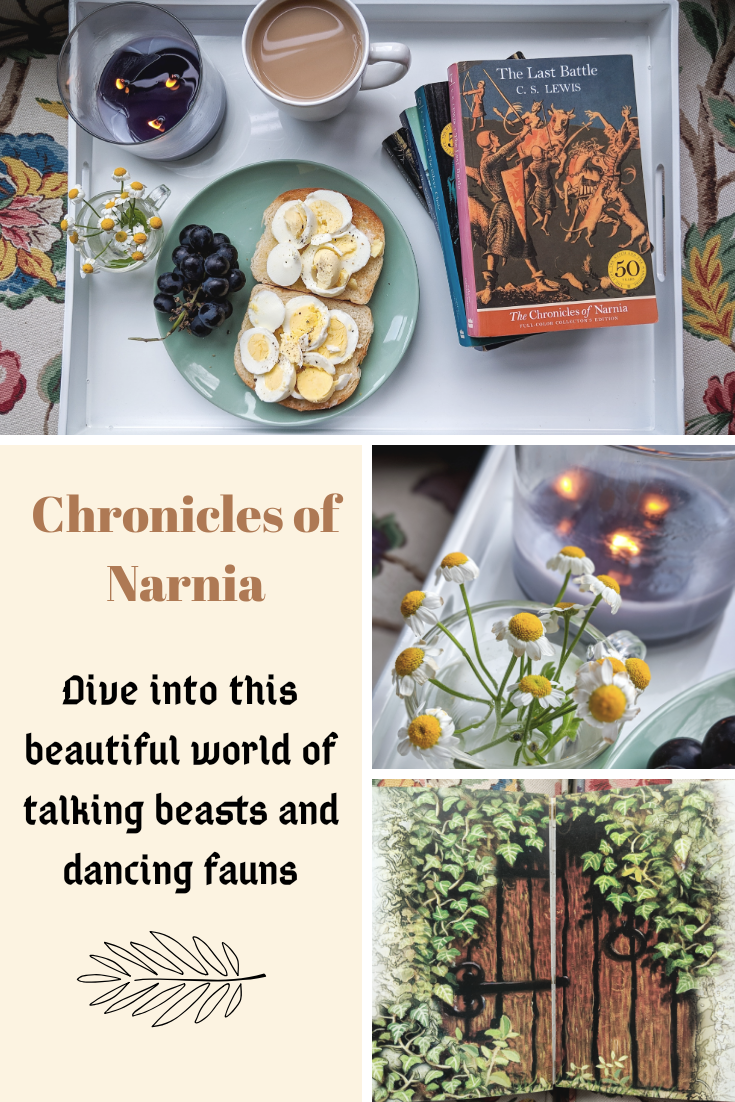
I recently reread all the Chronicles of Narnia books. They’re some of my favorites. I still remember when my dad came home with a box set of the series. I loved when my dad brought home new books for me to read. The box set was the 50th anniversary editions with colored illustrations and they were so fun to go through. Recently Netflix announced they would be making the Chronicles of Narnia into a TV series, and I’ve been waiting impatiently for updates since then. I’ve been meaning to re-read the series for a while and now seemed like the perfect time with that announcement.
My box set has the books in chronological order (based on Narnian time) rather than by order of publication (it differs slightly) and I recommend reading it in that order because it will build on previous characters and events and make more sense.
I’m doing just one big post on all the books since I finished reading them all before writing any reviews. Don’t mind all my photos with the books and my tea set. Reading books written by English authors often have scenes with tea in them and then all I want to do is drink tea and read all day. Rereading this series after having been to England myself, I can see how the English countryside inspired C.S. Lewis. It made it easier to picture the rolling green hills of Narnia with birdsong and the gentle trickle of rivers in the distance. We’ve had such a lovely rainy spring it’s offered many chances for me to curl up with a book in our library with candles lit and immerse myself in magic and fantasy.

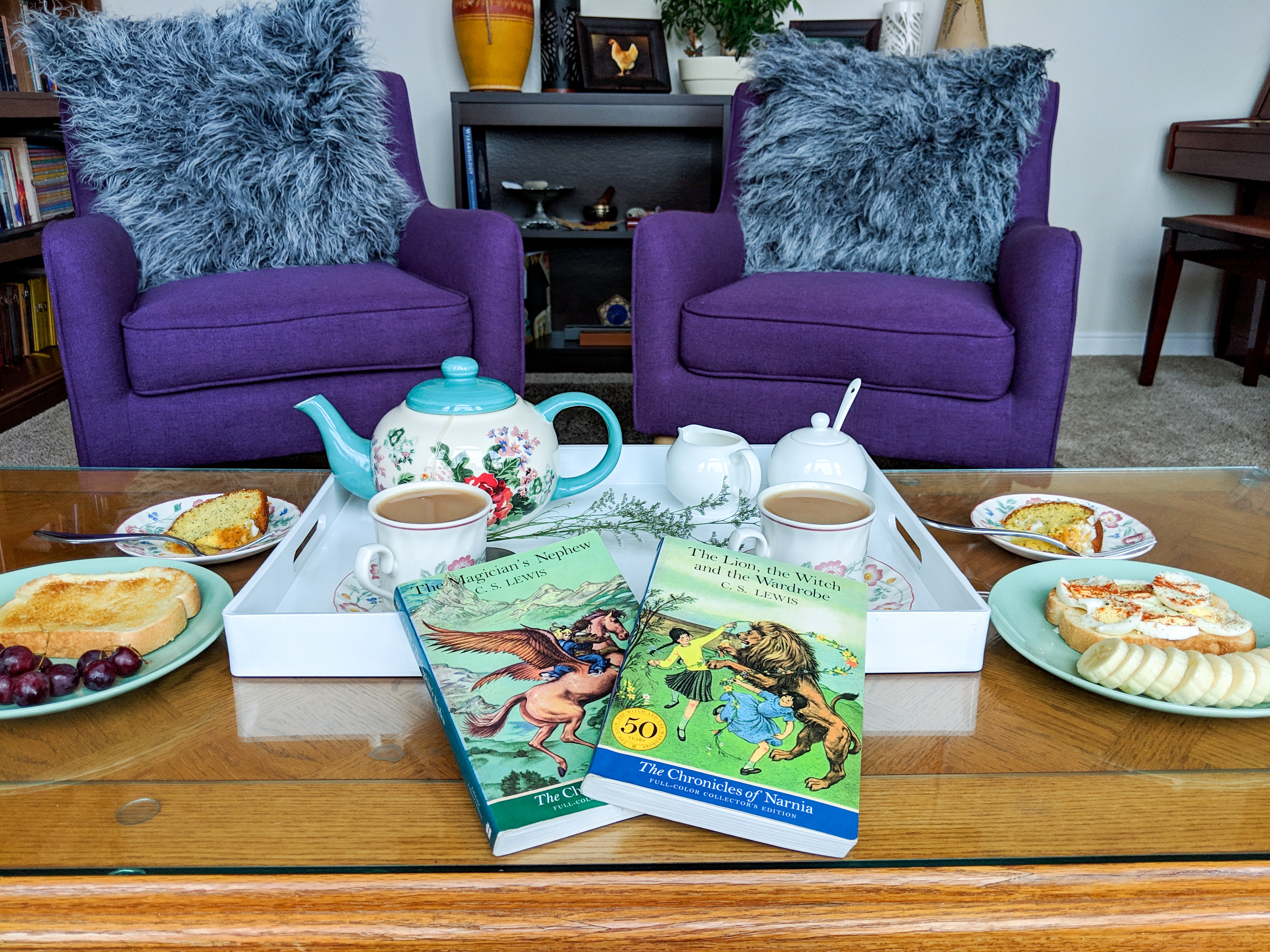
The Magician’s Nephew:
Two children are pulled into unknown worlds when a wicked and selfish uncle tricks them for a magic experiment. There they meet Jadis, an evil Queen trying to escape her dying world. Through a series of events she ends up in the middle of London with them and causes all sorts of mischief. When the children finally get her out of London, they end up in an empty world that is being created by Aslan. Aslan sends the children off on a task and the adventures of Narnia begin.
C.S. Lewis paints such a lovely beginning to Narnia, and while it’s a children’s book it never fails to draw me in to the magic of the story. The characters are realistic (well I guess their personalities are, perhaps not the talking Lion) and you’re drawn into Digory’s impulsive nature and Uncle Andrew’s egotism.
Lewis sets part of the story on a dying world, and paints a grim and sad version of it. The creation of Narnia is a stark contrast to the dying world and makes it all the more exciting to read about.
The Lion, the Witch, and the Wardrobe:
When four children stumble through a wardrobe into a magical forest with talking animals, they soon find that there is evil afoot and they must do their best to fix the spell cast over the land of Narnia. With Aslan’s help, they must defeat the evil witch who cast the spell and earn their places as Kings and Queens of Narnia.
This is the most well-known of the Narnia books, probably partially because of the movie. I think this is one of my favorite books in the series. Reading it as a child made me hope that every door I opened would be a door into another world. The dynamic between the four siblings is well-written, including their little arguments and growth throughout the book. There are definite Christian symbolisms in this story, but that doesn’t bother me while reading. This story includes the best of Narnia- beautiful country, talking animals, Aslan, Fauns, and dark magic. Aslan is an interesting character. He’s spoken of in the books as not being a ‘tame lion’. And indeed, whether because this was written in the 50s or talking lions are just a crazy idea, Aslan says and does things unexpectedly and strangely. He’s loving but stern, wild but gentle.
I love C.S. Lewis’s writing. His descriptions are simple yet beautiful, like Tumnus the faun’s cave.
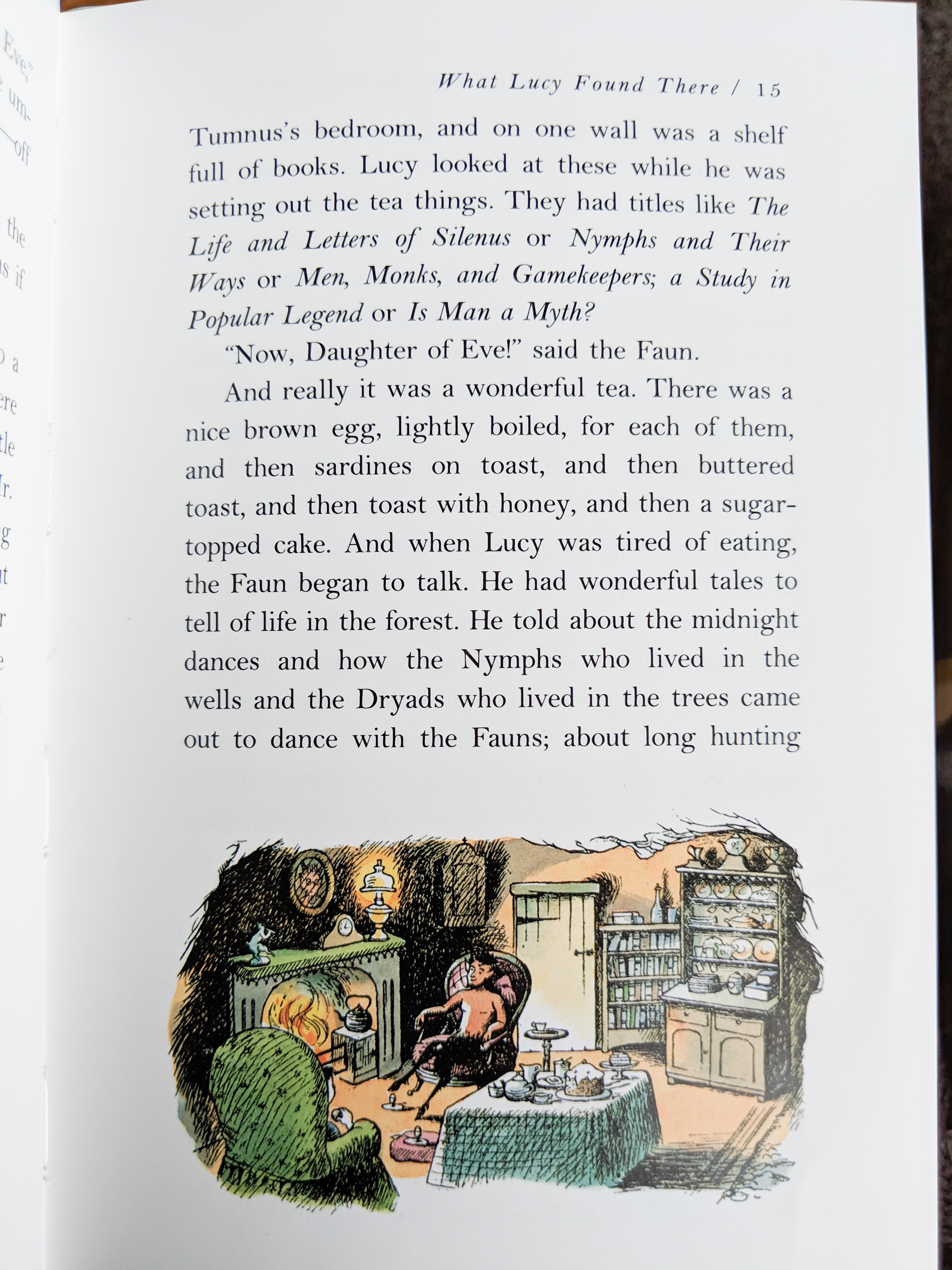
*Spoiler below*
If you’ve already watched the movie then this won’t spoil the book for you. When Lucy first discovers Narnia and comes back out of the wardrobe, and when the children arrive back home at the end of the book, they realize that no time has passed at all even though they’ve lived days or a whole lifetime in Narnia. I was always fascinated with this concept because it gave you the opportunity to live multiple lifetimes in one. I spent hours as a child daydreaming (and still do) about what time period or magic world I’d love to be whisked into to live a whole life and then return to this one.
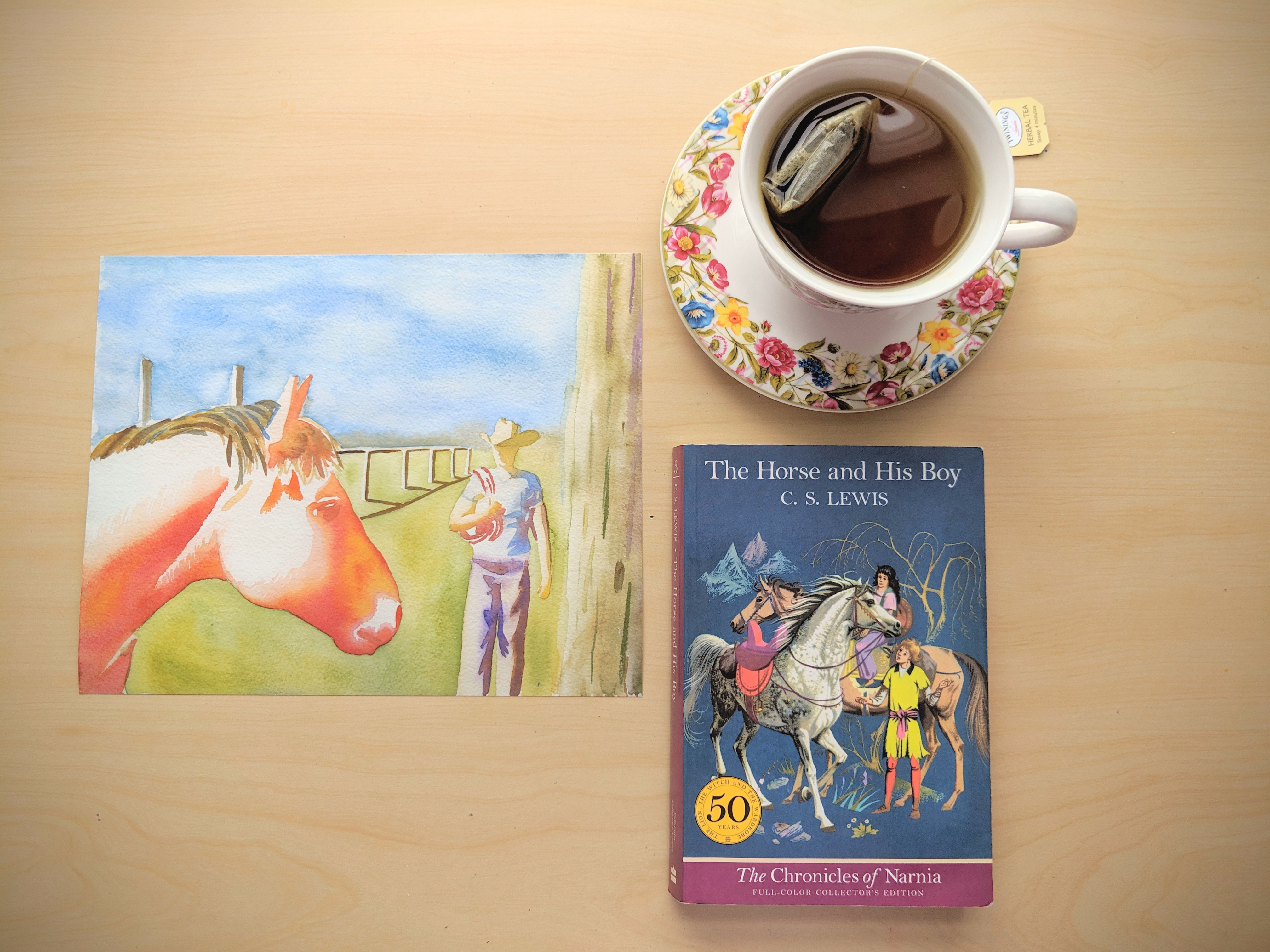
This is a painting I did! Prints available in my shop!
The Horse and His Boy:
Adopted orphan Shasta runs away from his abusive father when a talking horse wins him over with descriptions of the beautiful and free country to the north: Narnia. Along the way they meet fellow runaways Aravis and Hwin and together they travel in secret up the country. When a plot against Narnia is discovered, the travelers race across a vast desert to beat the invaders northward and warn the Narnians.
This is a side-story of Narnia set while the Pevensie children are still Kings and Queens of Narnia, though they play lesser characters in this book. The book takes place in an entirely different place and culture, and it’s fun to read about the differences between Narnia and Calormen. Aslan also features in this story, and again, he’s not a ‘tame lion’ and you wonder a little about his reasons for doing what he does. Shasta and Aravis are fun characters, as well as Bree and Hwin, the talking horses.
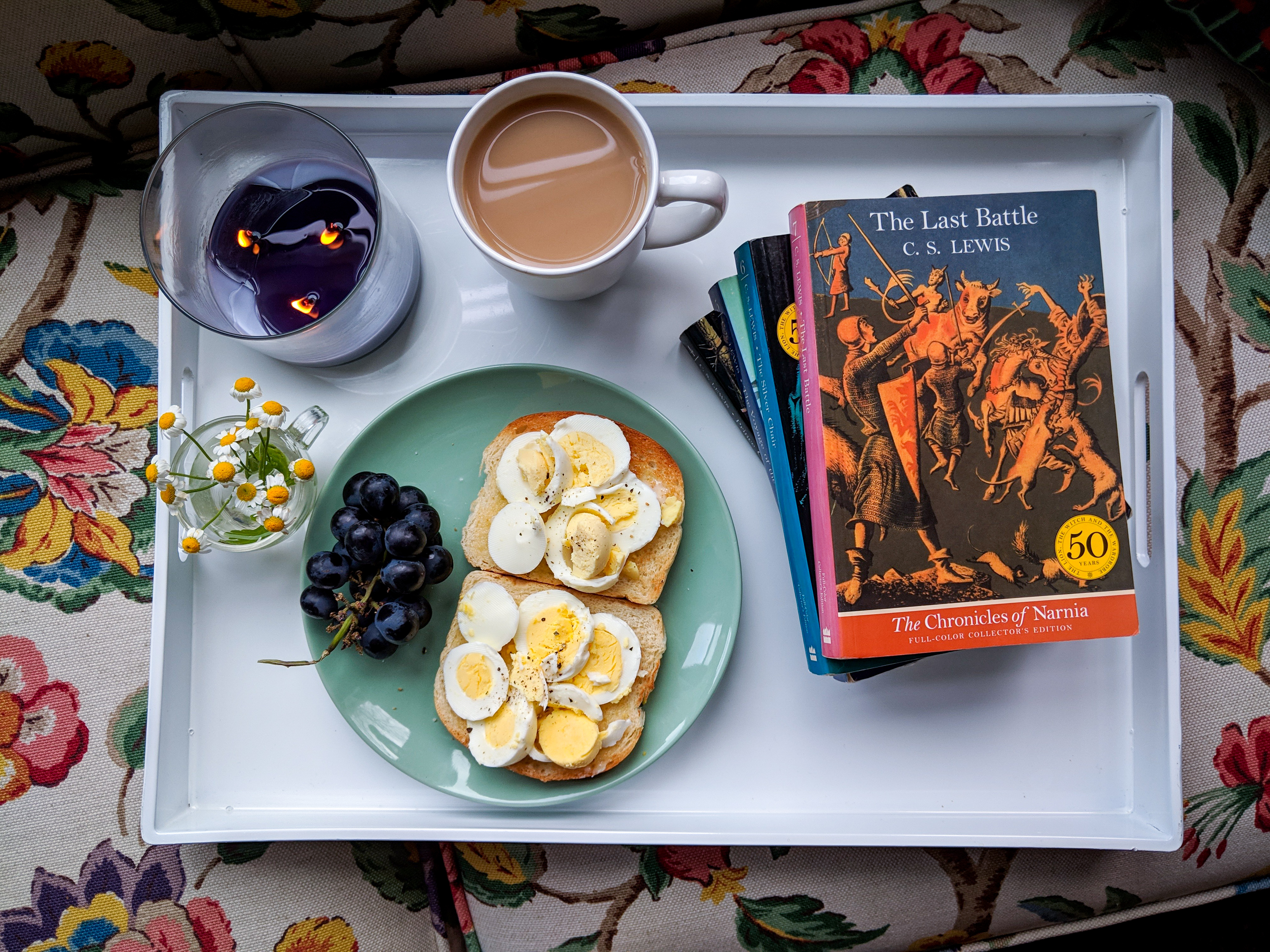
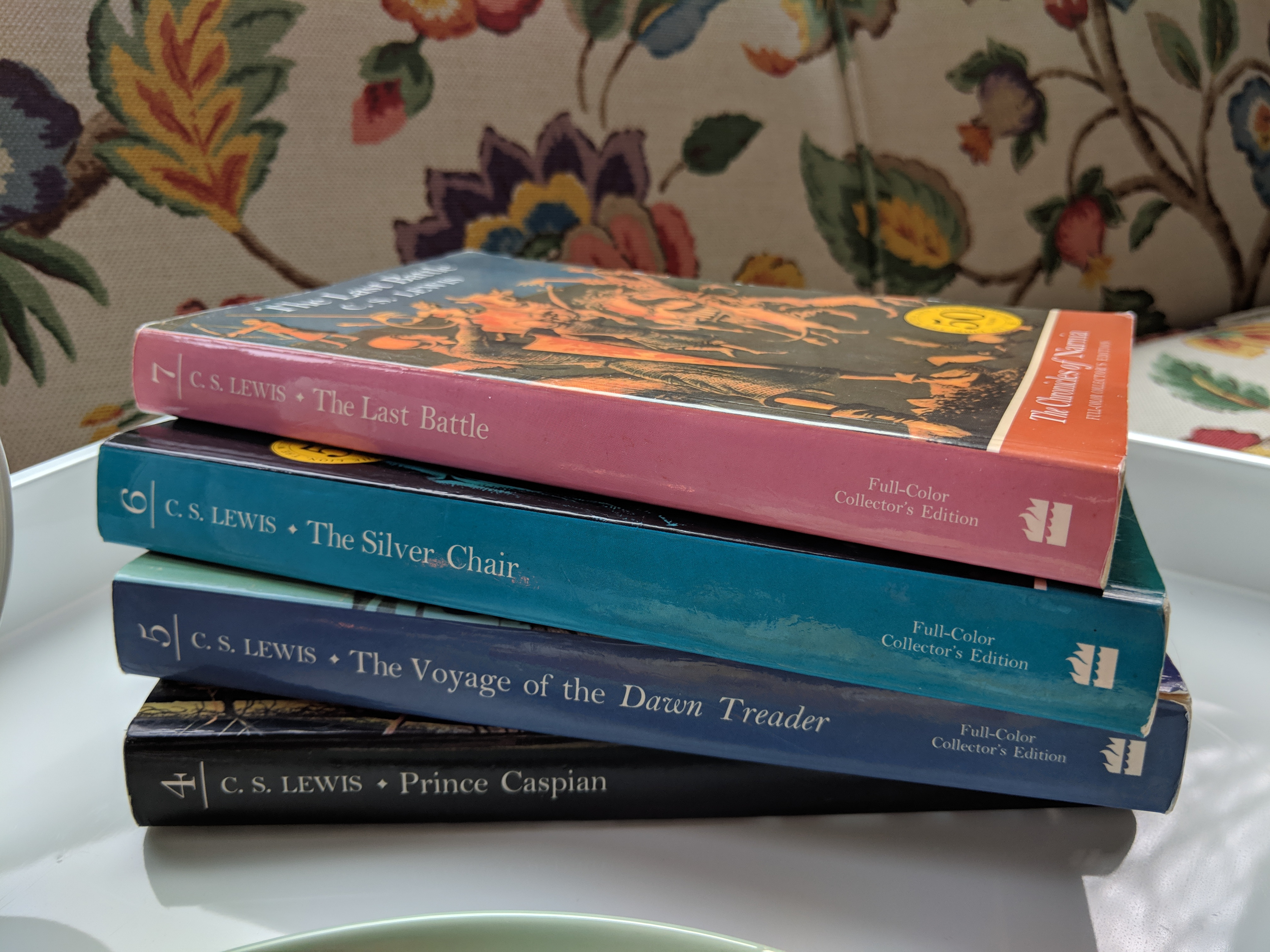
Prince Caspian:
Prince Caspian discovers his life is in danger when his uncle produces a new heir. Having been taught about Aslan, Old Narnia, and talking beasts, Caspian runs away and searches for the Narnians while his uncle pursues with an army. The Pevensie children are once again pulled out of England to help rescue Narnia from outsiders.
This book is a little different in setting, as part of the story is told in retrospect after the first few chapters. The Pevensie children feature again in this book, though they arrive back in Narnia over 1000 years after they last visited and come to find their castle in ruins and the country overtaken by people rather than their dear talking animals. Prince Caspian fights for his life and his right to rule from his wicked Uncle Miraz. You expect there to be a large battle at the end of this book but the ending is a little different than predicted, which some may like and others dislike. I’m still on the fence, because I do like reading thrilling battle scenes, but as it’s a children’s book the ending is maybe more diplomatic and creative in a less gory sort of way. A good read nonetheless that sets up the second half of the Narnia series.
The Voyage of the Dawn Treader:
Caspian, now King of Narnia, sets sail to the east in search of the seven lords his Uncle Miraz had exiled in the past. Along the way they discover new lands, escape from sea monsters, and perhaps will sail right over the edge of the world into Aslan’s country.
I think my favorite book in the series has got to be between this and The Lion, the Witch, and the Wardrobe. Prince Caspian returns as one of the main Narnian characters, and the children from our world are Edmund, Lucy, and their annoying prick of a cousin Eustace. In this story you meet new lands, new people, and new creatures. It’s an exciting read because the travelers are discovering most of these places for the first time and you, as reader, discover all these places with them and you get to experience the mystery and wonder along with the characters. I just love the descriptions of all the islands and new magic you read about. And I also like that one of the characters, Caspian, is carried over from the previous book and you get to know him better. There’s also a chance of them sailing to the end of the world, so the whole time you wonder what it might look like if they do make it, and whatever you might imagine it’s not disappointing!
The Silver Chair:
Eustace and Jill are pulled into Narnia while being chased by bullies, and Aslan gives them a difficult task with signs to help them along the way. When it seems they’ve messed up all the signs, the children and their new friend, a Marsh-wiggle named Puddleglum, must outsmart giants and an evil sorceress to find a missing prince and restore him to the throne of Narnia.
This is the first book of the series in which none of the original Pevensie children are in it. It’s a different sort of setting that takes place on gloomy moorlands, snowy mountains, and underground, so not your typical bright happy Narnian scene. A couple new characters are a bit more annoying to me, and it may be partly that if you’ve made it this far, your knowledge of Narnia is much greater than that of the characters. I do like Prince Rillian’s character, and the children grow throughout the book. You also get to learn more about Aslan’s mysterious country.
The Last Battle:
When a false Aslan roams Narnia, everyone is confused. Should they obey him? Hide from him? Confront him? Tirian, King of Narnia, calls for aid from the children, friends of Narnia who have helped save the country in the past. The book culminates in a clash between the Narnians and Calormenes, and the Last Battle is fought with the odds against King Tirian.
*Spoilers in my review* 3/5 stars if you want to skip it.
This last book I simultaneously like and dislike. The Christian themes in this are much harder to ignore than in The Lion, The Witch, and the Wardrobe, and it may be because it’s preachier in this book. The false prophet, the ending of the world and who gets to go to Aslan’s country vs. Tash’s country, Susan no longer being a ‘friend of Narnia’ (aka no longer believing in Narnia). The book also reveals the time period of racist beliefs C.S. Lewis lived in. The Calormenes are the bad guys, they smell of ‘onion and garlic’, and the dwarves insult them as ‘darkies’. It’s more shocking to read this as an adult than as a kid. But I do realize that it reflects the time period perhaps more than the author’s beliefs. (I don’t know if he was racist, but Lewis did write good Calormene characters such as Aravis in The Horse and His Boy.) It’s a little bit more of a slower start than the other books, and Eustace and Jill don’t arrive until partway through the book. I do like the characters of King Tirian and Jewel the unicorn. I feel like the ending was beautiful yet abrupt, and I was rather disappointed in the ‘last battle’, which wasn’t much of a battle at all. Aslan ends the world of Narnia and you see all the old characters from the previous book which is very fitting, and how the world ends is described creatively. I don’t love that Susan isn’t with everyone at the end, I feel like it was the author making a religious point, but for me I wanted this to be a happy ending in a children’s series where all the old friends see each other again.
I give it 3/5 stars because I did like the characters, the way the story was told, and the ending in Aslan’s country. But I didn’t love the blatantly religious themes (and I grew up religious), the lack of an exciting battle, the pace of the story compared to the previous books, and Susan being left alone when her parents and siblings have all just died.
Phew, that took longer to write than I though, I shouldn’t try to do seven book review at once!
One of the books we have has a timeline of all the events of Narnia. If you won’t want spoilers don’t look at it.
